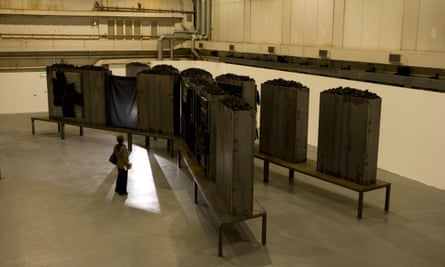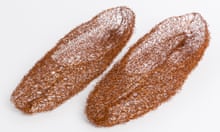Jannis Kounellis, who has died aged 80, made a highly distinctive contribution to one of the most provocative artistic movements in postwar Europe. As a pioneer of arte povera in the late 1960s, he created spectacular sculptures out of “poor”, mundane objects – pieces of wood, coal, sacking, steel and lead, arranged in startling juxtapositions on gallery walls or piled unceremoniously on the floor. In this way the materials’ different physical qualities and functional associations were emphasised to strengthen their viewers’ perception of everyday reality.
This old-fashioned faith in the life-enhancing powers of art was accompanied by a preoccupation with Europe’s ancient heritage, obscured as it was by the confusion of contemporary society. Consequently, in contrast to their “poorer” companions, some of Kounellis’s installations had gold surfaces, influenced by Byzantine art, or, after the mid-70s, classical fragments – plaster heads blindfolded or punctured with gas flames. As he himself put it, the artist is always “engaged in a permanent dialogue with the culture of the past”, even if this does not reflect particularly well on the present.
Kounellis’s feeling for antiquity is perhaps unsurprising. Born in Piraeus, the port of Athens, son of Gregory and Evangelia Kounellis, he emigrated to Rome at the age of 20, after initially studying art in Athens. His move was supported by his father, who had spent the second world war in the Greek resistance and then himself left for the US, where he worked as a mechanic. Like his predecessor Giorgio de Chirico, also active in Italy but born in Greece, Kounellis had a complex Mediterranean identity: for him his native land was more, he said, “an opinion” than a place. He rarely went home to Greece, and for many years his only show in Athens was a performance in a taverna as Apollo, to the accompaniment of a flute.

As a student in Rome, Kounellis’s appreciation of his cultural roots did not isolate him from more contemporary influences. While attending the city’s Accademia di Belle Arti in the late 1950s, he was profoundly affected by the most avant-garde Italian art, ranging from Alberto Burri’s stitched scraps of sacking to Piero Manzoni’s “achromes” – completely white canvases covered with unorthodox materials such as China clay, felt or rolls of bread. The blankness of Manzoni’s work was partly a reaction to the expressive qualities of art informel, the free abstract style that dominated the European avant-garde at this time.
Manzoni’s spirit of rebellion was shared by Kounellis, as was clear from the younger artist’s first one-man exhibition, held in 1960 at the Galleria La Tartaruga in Rome. He displayed a series of audacious paintings entitled Alphabets, in which he stencilled letters, numerals, even traffic markings – the most impersonal, universal signs – onto otherwise abstract canvases. Even here, however, Kounellis’s vitality is irrepressible. The symbols crowd and jostle, as if desperate to burst out of their two-dimensional surfaces: Kounellis actually sang them in a series of happenings at the gallery.
Despite the originality of their imagery, Alphabets were in a conventional medium which Kounellis eventually abandoned. The installations that he made in the late 60s exchanged oil on canvas for shelves, doors and bed-frames, whose presence in sleek gallery settings managed to be both striking and somehow rather comforting. An air of deranged domesticity was cleverly combined with a more serious purpose: the archetypal objects suggested qualities of permanence and stability that contrasted with the general disorder of modern civilisation.
The end of the decade was marked by popular protest in Europe and North America, clearly reflected in the activities of the arte povera movement, whose first exhibition was organised in 1967 by the Genoese critic Germano Celant. The work of Kounellis’s colleagues Michelangelo Pistoletto and Luciano Fabro alluded directly to the Vietnam war and to calls for social change at home. Kounellis’s own topical references in the late 60s and 70s were, in contrast, often so subtle as to be almost unrecognisable: a patch of soot on a wall might refer to the extinguished flames of radicalism, or, more simply, to the elemental forces of fire and earth.
It is, perhaps, this universal quality that gave Kounellis his durability. While the 1980s were marked by a renewal of figurative art, especially in the Italian transavanguardia movement, Kounellis remained faithful to his principles. Indeed, decades later a casual viewer might have thought he was using the same wardrobes, blocked doorways and shelving units as in the first years of arte povera. He even showed live starlings at the Ace Gallery, New York, in 1998, recalling the scarlet macaw and 11 horses that had animated his installations 30 years before. The main difference lay in Ace’s increased emphasis on conservation – starlings are the most common species of birds in the eastern US – and animal rights.
Kounellis’s later career did not always follow predictable lines. In 2000, he illustrated the apocryphal gospel of St Thomas with a series of esoteric cosmic and spiritual symbols printed in ink and sand. Two years later, he designed Wagner’s Lohengrin for Dutch National Opera and a set of espresso cups for the coffee company Illy. Moreover, throughout this time he developed his distinctive artistic philosophy in writings such as the collection Echoes in the Darkness (2002).
The final years were marked by important retrospectives. His exhibition at Tate Modern in 2009 included revivals of his work from the late 60s, with the organic materials – sacking, beans and pulses – necessarily renewed, and last year’s show at White Cube, Mason’s Yard, in London focused on examples of his early alphabet paintings. He also contributed in 2015 to Codice Italia, the Italian pavilion at the 56th Venice Biennale.
Further afield, in 2011 Kounellis appeared in galleries in Moscow and Beijing, while a year later he reaffirmed his hellenic roots at the Museum of Cycladic Art in Athens. His characteristic repertoire – old shoes and coats, soil, sacking and coal – was spread across the neoclassical building. Garnered on this occasion from Athenian junkyards and markets, these materials created a complex, even disturbing, dialogue with the surrounding relics of antiquity as well as with Greece’s contemporary reality.
He is survived by his partner, Michelle Coudray, by a son, Damiano, from his marriage to Efthimia Sardi, and by two grandsons.






Comments (…)
Sign in or create your Guardian account to join the discussion